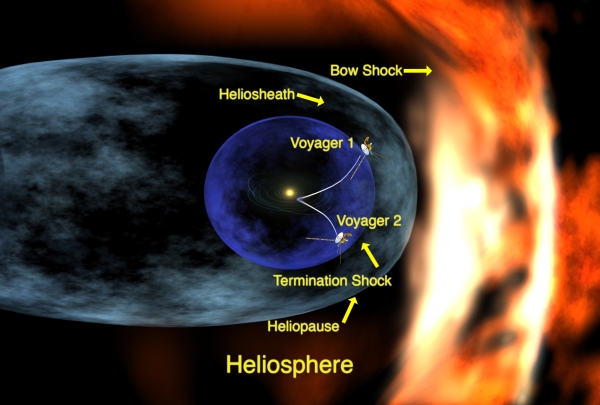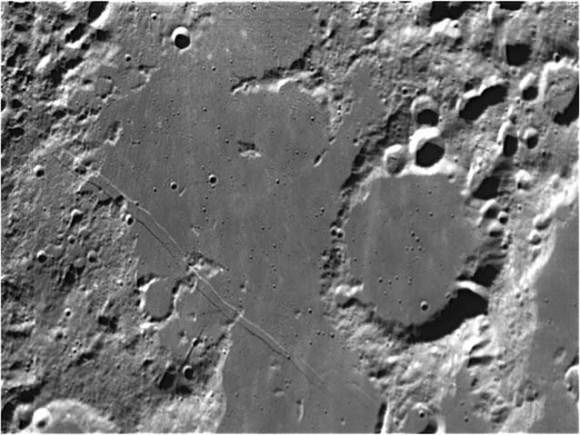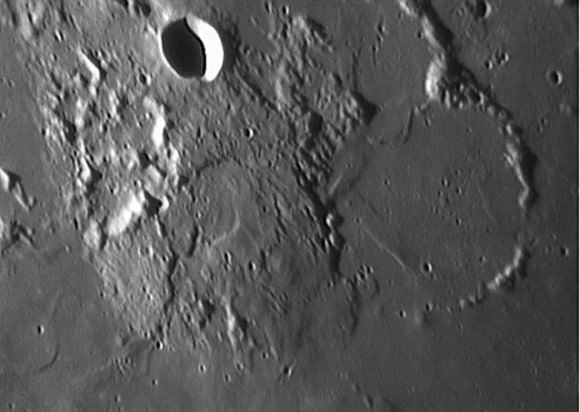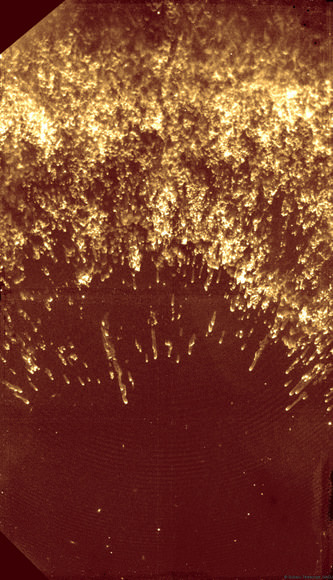Planetary Alignment
[/caption]
Thousands of years ago, men looked to the planets to guide them. Planetary alignments foretold momentous events of good and evil. In those days, planning wedding,s or even assassinations, according to the planets and stars was common in many cultures. Many people still look to the planets to tell the future. But what really is a planetary alignment and how does it happen?
There are two different ways that the term alignment is used referring to the planets in our Solar System. The first way is if you were standing on the Sun, all the planets would appear to be lined up in a row. This is what most people think of when the they hear the term planetary alignment. The other kind of alignment is if all the planets follow a straight line. In other words, it is as if a straight line can be drawn through the center of all the planets.
It is impossible for an exact alignment as viewed from the Sun – where the planets are superimposed – because of the differences in axial tilts of the planets. What we actually see in the sky is planetary configuration where the planets are in the same quadrant. It is very rare for all the planets to be within the exact same quadrant – approximately 90° of each other. Having all the planets within about 90° of each other only occurs about every 200 years, which is a long time for humans, although it is nothing for the universe. The planets do however line up loosely more often than that.
In 2000, five of the planets – Mars, Saturn, Jupiter, Mercury, and Venus were within 50° of each other. You may have heard a lot about future planetary alignments, including rumors about 12/21/2012 when some say the world is going to end, and there will be a planetary alignment. That is all it is, a rumor. There will be no planetary alignment in 2012. Many of the planets will align in a rather straight line in 2010. On June 13, 2010, Uranus, Jupiter, and Mercury will be lined up on one side of the Sun while Venus, Mars, and Saturn will be lined up on the other side. Earth will be perpendicular to the Sun at this time. In September of the year 2040, four of the planets – Saturn, Venus, Jupiter and Mars – will be roughly aligned when seen from Earth. Check out when other planetary alignments will happen, and then search for them in the sky.
Check out this site about planetary alignments and this site, which shows you the position of the planets for any date you enter.
Universe Today has a number of articles to read including galactic alignment and planets line up.
Astronomy Cast has an episode about planetary alignment.
What is Interplanetary Space?
[/caption]
The region of space within our Solar System is called interplanetary space, also known as interplanetary medium. Most people are so fascinated by the planets, Sun, and other celestial objects that they do not pay any attention to space. After all, there is nothing in outer space right? A common misconception is that outer space is a perfect vacuum, but there are actually particles in space including dust, cosmic rays, and burning plasma spread by solar winds. Particles in interplanetary space have a very low density, approximately 5 particles per cubic centimeter around Earth and the density decreases further from the Sun. The density of these particles is also affected by other factors including magnetic fields. The temperature of interplanetary medium is about 99,727°C.
Interplanetary space extends to the edge of the Solar System where it hits interstellar space and forms the heliosphere, which is a kind of magnetic bubble around our Solar System. The boundary between interplanetary space and interstellar space is known as the heliopause and is believed to be approximately 110 to 160 astronomical units (AU) from the Sun. The solar winds that blow from the Sun, and are part of the material in interplanetary space, flow all the way to the edge of the Solar System where they hit interstellar space. The magnetic particles in these solar winds interact with interstellar space and form the protective sphere.
The way that interplanetary space interacts with the planets depends on the nature of the planets’ magnetic fields. The Moon has no magnetic field, so the solar winds can bombard the satellite. Astronomers study rocks from Earth’s Moon to learn more about the effects of solar winds. So many particles have hit the Moon that it emits faint radiation. Some planets, including Earth, have their own magnetospheres where the planets’ magnetic fields override the Sun’s. The Earth’s magnetic field deflects dangerous cosmic rays that would otherwise damage or kill life on Earth. Material leaking from the solar winds is responsible for auroras in our atmosphere. The most famous aurora is the Aurora Borealis, which appears in the sky and is only visible in the Northern Hemisphere.
Interplanetary medium also causes a number of phenomena including the zodiacal light, which appear as a faint broad band of light only seen before sunrise or after sunset. This light, brightest near the horizon, occurs when light bounces off dust particles in the interstellar medium near Earth. In addition to interplanetary space, there is also interstellar space, which is the space in a galaxy in between stars.
Universe Today has a number of articles on space including the heliosphere and zodiacal light.
Check out these articles from NASA on the heliosphere and sunspots leaking plasma into interplanetary space.
Astronomy Cast has an episode on the heliosphere and interstellar medium.
References:
NASA: Heliosphere
NASA Voyager: Interstellar Mission
What’s It Like Where Voyager Is?
What is Mercury Made Of?
[/caption]
Mercury is the closest planet to the Sun, orbiting at only 57.9 million km. It’s classified as one of the “rocky” or terrestrial planets of the Solar System. But what is Mercury made of? How does Mercury’s composition compare to the other planets in the Solar System.
Scientists believe that Mercury has an interior composition similar to Earth. Mercury has a large core of liquid metal surrounded by a mantle of silica and a solid outer crust. In the case of Mercury, though, the core accounts for 42% of the planet, while Earth’s core is only 17%.
It’s difficult to know the actual interior composition of Mercury. Scientists know that it has a density of 5.427 grams per cubic centimeter. This is only a little less than our own planet. That means that Mercury has an interior metal core, and the rest is rock. In fact, Mercury’s core is thought to have a higher iron content than any other planet in the Solar System. It’s believed that Mercury used to be similar in composition to a chondrite meteorite, but then it was struck by a planetesimal early in its history that stripped away its outer crust and mantle. The remaining planet was much denser.
Astronomers were unsure if Mercury’s core was solid or liquid until recently. They bounced radio signals off the surface of the planet and measured how long they took to return. They determined that Mercury was wobbling at a rate you would expect if its core was liquid and not solid.
Mercury’s surface is similar in appearance to the Moon, with large basins and impact craters. The largest crater is Caloris Basin, measuring 1,550 km across. The impact that created Caloris Basin sent shock waves around the planet, causing volcanic activity on the opposite point of the impact.
We have written many stories about what is Mercury made out of here on Universe Today. Here’s an article about a the discovery that Mercury’s core is liquid. And how Mercury is actually less like the Moon than previously believed.
If you’d like more information on Mercury, check out NASA’s Solar System Exploration Guide, and here’s a link to NASA’s MESSENGER Misson Page.
We have also recorded a whole episode of Astronomy Cast that’s just about planet Mercury. Listen to it here, Episode 49: Mercury.
Mercury and Pluto
[/caption]
Before Pluto was discovered, there were 8 planets in the Solar System; and Mercury was the smallest. And then in 1930, the discovery of Pluto brought that number up to 9. For most of the 20th century, scientists weren’t sure which was bigger, Pluto or Mercury. But accurate measurements helped scientists conclude that Pluto was the smaller planet. And then in 2006, astronomers voted to remove Pluto as a planet, and so we’ve got back to 8 planets. And once again, Mercury is the smallest planet in the Solar System. But let’s compare the dwarf planet Pluto and Mercury.
In terms of size, scientists now know that Mercury is significantly larger than Pluto. The diameter of Mercury is 4,879.4 km across, while Pluto’s diameter is 2,360 km across. So Mercury is about twice as large Pluto. And just for comparison, Pluto is only 18% the diameter of Earth, while Mercury is 38% the diameter of Earth.
When it comes to density, though, Mercury and Pluto are very different. Mercury is comprised of rock and metal, while Pluto is ice and rock. The density of Mercury is 5.427 g/cm3, while the density of Pluto is about 2 g/cm3. And since Pluto is smaller and less dense than Mercury, it has a much lower force of gravity. While you would feel 38% the force of Earth gravity standing on the surface of Mercury, you would experience only 5.9% of Earth gravity on Pluto. It would be extremely difficult to walk around the surface of Pluto without flying up in the air with every step.
Mercury is the closest planet to the Sun, orbiting at an average distance of only 57.9 million km, while Pluto orbit at an average distance of 5.9 billion km. Mercury completes an orbit in just 88 days, while Pluto takes 248 years to go around the Sun just once.
Mercury has no rings or moons, while Pluto has at least 3 moons (Charon, Nix and Hydra) and might even have faint ice rings; these could be generated by meteorite impacts on the surface of Pluto kicking up material into orbit around it.
There’s one big difference between the two worlds, though. It’s possible to see Mercury with the unaided eye. If you head out before sunrise, or after sunset and look to the horizon, you can see Mercury with your own eyeballs. Pluto, on the other hand, requires a very powerful telescope; and even then it’ll only look like a faint dot.
Another difference is the fact that Mercury has been visited by spacecraft from Earth. This has given us close up images of the surface of the planet. Pluto has never been seen up close. That’s going to change soon, though, when NASA’s New Horizons spacecraft arrives at Pluto in 2015 and takes the first close up images of the dwarf planet.
We have written many stories about Mercury here on Universe Today. Here’s an article about a the discovery that Mercury’s core is liquid. And how Mercury is actually less like the Moon than previously believed.
If you’d like more information on Mercury, check out NASA’s Solar System Exploration Guide, and here’s a link to NASA’s MESSENGER Misson Page.
Source: NASA
Weekend SkyWatcher’s Forecast: July 3-5, 2009
Greetings, fellow SkyWatchers! Are you ready for a Moon-filled weekend? Then let’s have a look a some great lunar features as we race Mad Max to the “Megadome”! For some lucky viewers in Japan and Hawaii, there will be an occultation of Antares to enjoy. How about some great double stars… Or a chance to see if you can spot a penumbral lunar eclipse? Then follow me out to the backyard. The stars are waiting…
Friday, July 3, 2009 – Tonight let’s venture toward the south shore of Palus Epidemiarum to have a high-power look at crater Capuanus. Named for Italian astronomer Francesco Capuano di Manfredonia, this 60 kilometer-wide crater boasts a still tall southwest wall, but the northeast one was destroyed by lava flow.
At its highest, it reaches around 1,900 meters above the lunar surface, yet drops to no more than 300 meters at the lowest. Look for several strikes along the crater walls as well as more evidence of a strong geological history. To the north is the Hesiodus Rima, a huge fault line that extends 300 kilometers across the surface!
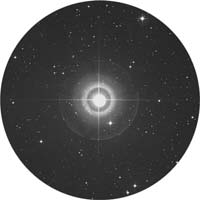 When you’re done, why not have a look at 156-light-year-distant Mu Serpentis (RA 15 49 37 Dec –03 25 48)? Its name is Leiolepis, which means ‘‘smooth scaled.’’ Perhaps a fitting name, because this normal A-type main sequence star is also known as the head of the serpent. Have a look in binoculars, and you’ll note several optical companions. Or use a telescope to locate delicate binary Struve 1985 (RA 15 56 01 Dec –02 11 00) nearby!
When you’re done, why not have a look at 156-light-year-distant Mu Serpentis (RA 15 49 37 Dec –03 25 48)? Its name is Leiolepis, which means ‘‘smooth scaled.’’ Perhaps a fitting name, because this normal A-type main sequence star is also known as the head of the serpent. Have a look in binoculars, and you’ll note several optical companions. Or use a telescope to locate delicate binary Struve 1985 (RA 15 56 01 Dec –02 11 00) nearby!
Saturday, July 4, 2009 – Look closely at the Moon. For some lucky viewers, it’s about to occult Antares! Check International Occultation and Timing Association (IOTA) for times and locations.
Also be sure to look for the ‘‘Cow Jumping over the Moon,’’ but power up with a telescope to study some very wild looking features—lunar lava domes. North of Aristarchus, west of Promontorium Heraclides, and near the terminator is Rumker—the largest of the lava domes. Only visible when near the terminator, this roughly 77-kilometer-diameter ‘‘soft hill’’ ranges anywhere from 60 to 760 meters tall. Although it is not much more than a bump on the lunar surface, it does contain a few summit craters at its highest points. What we are looking at is really an important part of the geology that shaped the Moon’s surface. In all likelihood, Rumker is a shield volcano. . .in an area of many!
Now continue east toward the prominent crater Marian, set in a bright peninsula extending into Sinus Roris and Mare Imbrium. Just southwest are two more—Mons Gruithuisen Gamma (the ‘‘Megadome’’) and Mons Gruithuisen Delta. Although you might not find these features particularly impressive, consider that we’re looking at something only 20 kilometers wide and only a few meters high!
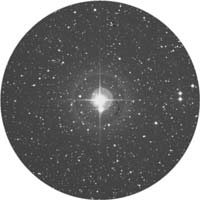 Tonight we honor American astronomer Henrietta Swan Leavitt, the discoverer of the relationship between period and luminosity in Cepheid variables. This led to understanding the distance to the galaxies! Said Leavitt, ‘‘Since the variables are probably nearly the same distance from Earth, their periods are apparently associated with their actual emission of light, as determined by their mass, density, and surface brightness.’’ Do her memory honor and check out Delta Cephei (RA 22 29 10 Dec þ58 24 54) tonight! Thirty to forty times more massive than our own Sun, Delta varies from magnitude 3.6–4.3 in just slightly over 5 days. And look for its companion star as well.
Tonight we honor American astronomer Henrietta Swan Leavitt, the discoverer of the relationship between period and luminosity in Cepheid variables. This led to understanding the distance to the galaxies! Said Leavitt, ‘‘Since the variables are probably nearly the same distance from Earth, their periods are apparently associated with their actual emission of light, as determined by their mass, density, and surface brightness.’’ Do her memory honor and check out Delta Cephei (RA 22 29 10 Dec þ58 24 54) tonight! Thirty to forty times more massive than our own Sun, Delta varies from magnitude 3.6–4.3 in just slightly over 5 days. And look for its companion star as well.
Sunday, July 5, 2009 – Tonight let’s go deep south and have look at an area that once held something almost half a bright as tonight’s Moon and over four times brighter than Venus. Only one thing could light up the skies like that—a supernova.
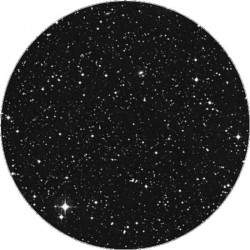 According to historical records from Europe, China, Egypt, Arabia, and Japan, 1,003 years ago the very first supernova event was noted. Appearing in the constellation of Lupus, it was at first believed to be a comet by the Egyptians, yet the Arabs saw it as an illuminating ‘‘star.’’ Located less than a finger-width northeast of Beta Lupi (RA 15 02 48 Dec –41 54 42) and half a degree east of Kappa Centaurus, no visible trace is left of a once-grand event that spanned 5 months of observation, beginning in May and lasting until it dropped below the horizon in September 1006. It is believed that most of the star was converted to energy, and very little mass remains. In the area, a 17th magnitude star that shows a tiny gas ring and radio source 1459-41 remains our best candidate for pinpointing this incredible event.
According to historical records from Europe, China, Egypt, Arabia, and Japan, 1,003 years ago the very first supernova event was noted. Appearing in the constellation of Lupus, it was at first believed to be a comet by the Egyptians, yet the Arabs saw it as an illuminating ‘‘star.’’ Located less than a finger-width northeast of Beta Lupi (RA 15 02 48 Dec –41 54 42) and half a degree east of Kappa Centaurus, no visible trace is left of a once-grand event that spanned 5 months of observation, beginning in May and lasting until it dropped below the horizon in September 1006. It is believed that most of the star was converted to energy, and very little mass remains. In the area, a 17th magnitude star that shows a tiny gas ring and radio source 1459-41 remains our best candidate for pinpointing this incredible event.
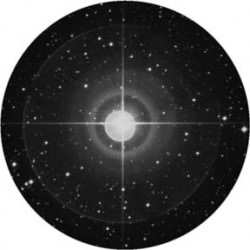 Why you’re at it, try a challenging double star—Upsilon Librae (RA 15 37 01 Dec –28 08 06). This beautiful red star is right at the limit for a small telescope, but quite worthy, as the pair is a widely disparate double. Look for the 11.5-magnitude companion to the south in a very nice field of stars!
Why you’re at it, try a challenging double star—Upsilon Librae (RA 15 37 01 Dec –28 08 06). This beautiful red star is right at the limit for a small telescope, but quite worthy, as the pair is a widely disparate double. Look for the 11.5-magnitude companion to the south in a very nice field of stars!
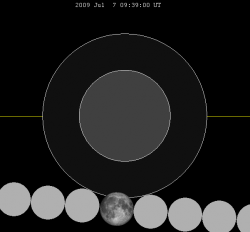 If you’d like to try for a challenging observation, then take look on the universal date of July 7th for a partial penumbral eclipse. While this isn’t anything to get intensely excited over, since the Moon will only graze through a small portion of the Earth’s shadow, chances are you might just notice something a little different. While a certain very reputable periodical says “The moon skims through too little of the penumbra to be noticed even by the most intent observer.” – I have also heard them say things like the partial solar eclipse won’t be visible here or there – and proved them wrong. It’s only my opinion, of course, but I believe no one should be discouraged from making an observation if they have the time, the energy, the location or the desire! So here’s what to do…
If you’d like to try for a challenging observation, then take look on the universal date of July 7th for a partial penumbral eclipse. While this isn’t anything to get intensely excited over, since the Moon will only graze through a small portion of the Earth’s shadow, chances are you might just notice something a little different. While a certain very reputable periodical says “The moon skims through too little of the penumbra to be noticed even by the most intent observer.” – I have also heard them say things like the partial solar eclipse won’t be visible here or there – and proved them wrong. It’s only my opinion, of course, but I believe no one should be discouraged from making an observation if they have the time, the energy, the location or the desire! So here’s what to do…
The partial penumbral eclipse will be seen starting in eastern Australia as the Moon rises just after dusk on July 7th and it will occur as the Moon is setting over western North and South America in the early predawn hours of July 7th. Only the northern third of the lunar surface will be affected, and it will be just a slight change in coloration – a vague gray shadowing. However, this is simply a prediction on the vague part! I have seen times when this happens that the appearance is very noticeable, and times when you truly can’t tell at all. Why not judge for yourself? I look forward to hearing your results!
Good luck and clear skies…
This week’s awesome images are: Capuanus, Marian and the Megadome (credit—Wes Higgins), Mu Serpentis, Delta Cephei, Field of SN 1006 and Upsilon Librae (credit – Palomar Observatory, courtesy of Caltech). We thank you so much!
Happy Fourth of July!
[/caption]
Astronomers working with the Subaru Telescope have released these new images of a “fireworks display” in a near-infrared image of the Helix Nebula, showing comet-shaped knots within.
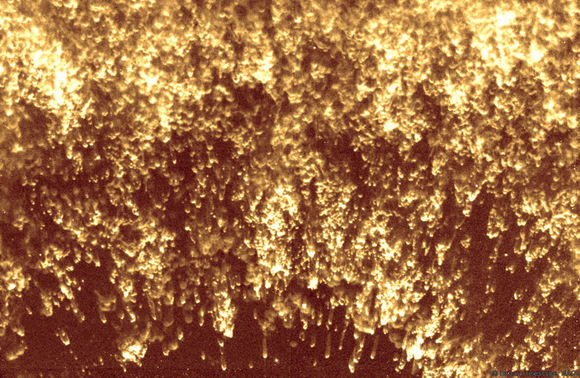
The Helix Nebula, NGC 7293, is not only one of the most interesting and beautiful planetary nebulae; it is also one of the closest nebulae to Earth, at a distance of only 710 light years away. The new image, taken with an infrared camera on the Subaru Telescope in Hawaii, shows tens of thousands of previously unseen comet-shaped knots inside the nebula. The sheer number of knots–more than have ever been seen before—looks like a massive fireworks display in space.
The Helix Nebula was the first planetary nebula in which knots were seen, and their presence may provide clues to what planetary material may survive at the end of a star’s life. Planetary nebulae are the final stages in the lives of low-mass stars, such as our Sun. As they reach the ends of their lives they throw off large amounts of material into space. Although the nebula looks like a fireworks display, the process of developing a nebula is neither explosive nor instantaneous; it takes place slowly, over a period of about 10,000 to 1,000,000 years. This gradual process creates these nebulae by exposing their inner cores, where nuclear burning once took place and from which bright ultraviolet radiation illuminates the ejected material.
![Previous optical image of the Helix Nebula, demonstrating diffuse gas surrounding a central star. The white box shows the area observed by the Subaru Telescope. Credit: NASA, NOAO, ESA, the Hubble Helix Nebula Team, M. Meixner [STScI], and T.A. Rector [NRAO] Previous optical image of the Helix Nebula, demonstrating diffuse gas surrounding a central star. The white box shows the area observed by the Subaru Telescope. Credit: NASA, NOAO, ESA, the Hubble Helix Nebula Team, M. Meixner [STScI], and T.A. Rector [NRAO]](https://www.universetoday.com/wp-content/uploads/2009/07/afig4.jpg)
Astronomers from the National Astronomical Observatory of Japan (NAOJ), from London, Manchester and Kent universities in the UK and from the University of Missouri in the US studied the emissions from hydrogen molecules in the infrared and found that knots are found throughout the entire nebula. Although these molecules are often destroyed by ultraviolet radiation in space, they have survived in these knots, shielded by dust and gas that can be seen in optical images. The comet-like shape of these knots results from the steady evaporation of gas from the knots, produced by the strong winds and ultraviolet radiation from the dying star in the center of the nebula.
Unlike previous optical images of the Helix Nebula knots, the infrared image shows thousands of clearly resolved knots, extending out from the central star at greater distances than previously observed. The extent of the cometary tails varies with the distance from the central star, just as Solar System comets have larger tails when they are closer to the Sun and when wind and radiation are stronger. “This research shows how the central star slowly destroys the knots and highlights the places where molecular and atomic material can be found in space,”says lead astronomer Dr. Mikako Matsuura, previously at NAOJ and now from University College London.
These images enable astronomers to estimate that there may be as many as 40,000 knots in the entire nebula, each of which are billions of kilometers/miles across. Their total mass may be as much as 30,000 Earths, or one-tenth the mass of our Sun. The origin of the knots is currently unknown.
This paper will be published in the Astrophysical Journal in August 2009
Final image caption: Previous optical image of the Helix Nebula, demonstrating diffuse gas surrounding a central star. The white box shows the area observed by the Subaru Telescope. Credit: NASA, NOAO, ESA, the Hubble Helix Nebula Team, M. Meixner [STScI], and T.A. Rector [NRAO]
Source: NAO of Japan
Perchlorates and Water Make for Potential Habitable Environment on Mars
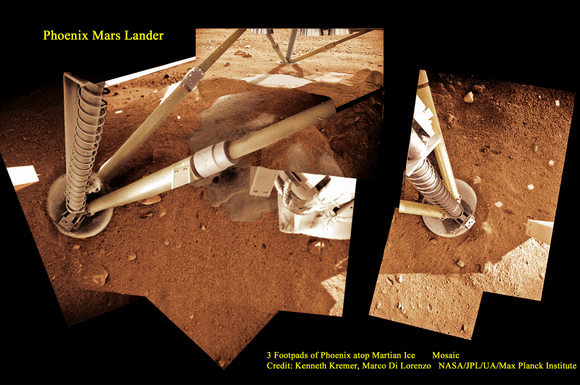
[/caption]
Scientists say that the Arctic region studied by Phoenix lander may be a favorable environment for microbes. Just-right chemistry and periods where thin films of liquid water form on the surface could make for a habitable setting. “Not only did we find water ice, as expected, but the soil chemistry and minerals we observed lead us to believe this site had a wetter and warmer climate in the recent past — the last few million years — and could again in the future,” said Phoenix Principal Investigator Peter Smith of the University of Arizona, Tucson.
The Phoenix science team released four papers today after spending months interpreting the data returned by the lander during its 5-month mission.
The most surprising finding was perchlorate in the Martian soil. This Phoenix finding caps a growing emphasis on the planet’s chemistry, said Michael Hecht of from the Jet Propulsion Laboratory, who led a paper about Phoenix’s soluble-chemistry findings.
“The study of Mars is in transition from a follow-the-water stage to a follow-the-chemistry stage,” Hecht said. “With perchlorate, for example, we see links to atmospheric humidity, soil moisture, a possible energy source for microbes, even a possible resource for humans.”
Perchlorate, which strongly attracts water, makes up a few tenths of a percent of the composition in all three soil samples analyzed by Phoenix’s wet chemistry laboratory. It could pull humidity from the Martian air. At higher concentrations, it might combine with water as a brine that stays liquid at Martian surface temperatures. Some microbes on Earth use perchlorate as food. Human explorers might find it useful as rocket fuel or for generating oxygen.
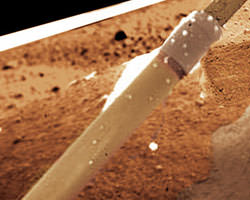
A paper about Phoenix water studies, led by Smith, cites clues supporting an interpretation that the soil has had films of liquid water in the recent past. The evidence for water and potential nutrients “implies that this region could have previously met the criteria for habitability” during portions of continuing climate cycles, these authors conclude.
Phoenix dug down with its scoop and found ice just under the surface of Mars. “We wanted to know the origin of the ice,” Smith said. “It could have been the remnant of a larger polar ice cap that shrank; could have been a frozen ocean; could have been a snowfall frozen into the ground. The most likely theory is that water vapor from the atmosphere slowly diffused into the surface and froze at the level where the temperature matches the frost point. We expected that was probably the source of the ice, but some of what we found was surprising.”
Evidence that the ice in the area sometimes thaws enough to moisten the soil comes from finding calcium carbonate in soil heated in the lander’s analytic ovens or mixed with acid in the wet chemistry laboratory. Another paper from a team led by University of Arizona’s William Boynton report that the amount of calcium carbonate “is most consistent with formation in the past by the interaction of atmospheric carbon dioxide with liquid films of water on particle surfaces.”
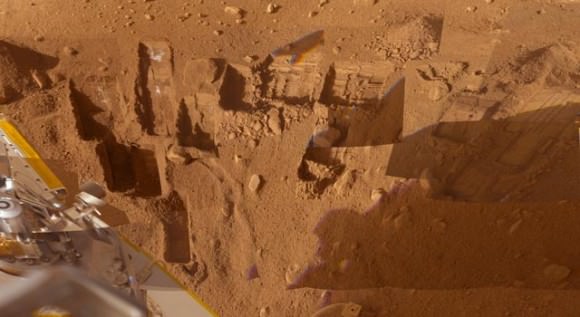
The new reports leave unsettled whether soil samples scooped up by Phoenix contained any carbon-based organic compounds. The perchlorate could have broken down simple organic compounds during heating of soil samples in the ovens, preventing clear detection.
The heating in ovens did not drive off any water vapor at temperatures lower than 295 degrees Celsius (563 degrees Fahrenheit), indicating the soil held no water adhering to soil particles. Climate cycles resulting from changes in the tilt and orbit of Mars on scales of hundreds of thousands of years or more could explain why effects of moist soil are present.
Phoenix launched in August 2007and landed in May, 2008. Phoenix ended communications in November 2008 as the approach of Martian winter depleted energy from the lander’s solar panels.
Sources: JPL, EurekAlert, Spaceflightnow.com
First Images from LRO
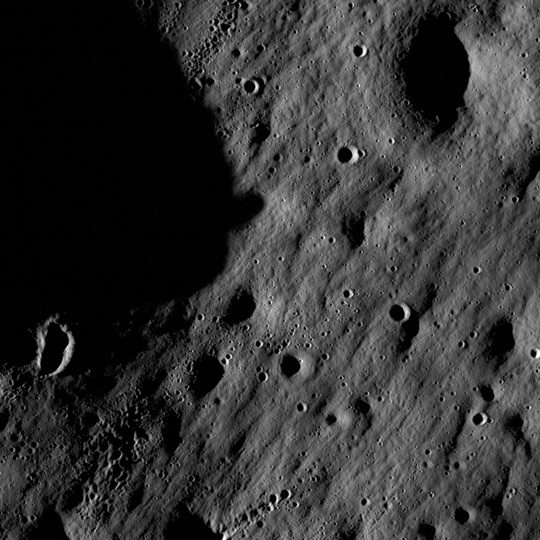
[/caption]
Woohoo! NASA’s Lunar Reconnaissance Orbiter has taken its first images of the Moon! There are two cameras on board which combine to create the Lunar Reconnaissance Orbiter Camera, or LROC. They were both activated June 30, and their “first light” images were of a region in the lunar highlands south of Mare Nubium (Sea of Clouds).
“Our first images were taken along the moon’s terminator — the dividing line between day and night — making us initially unsure of how they would turn out,” said LROC Principal Investigator Mark Robinson of Arizona State University in Tempe. “Because of the deep shadowing, subtle topography is exaggerated, suggesting a craggy and inhospitable surface. In reality, the area is similar to the region where the Apollo 16 astronauts safely explored in 1972. While these are magnificent in their own right, the main message is that LROC is nearly ready to begin its mission.”
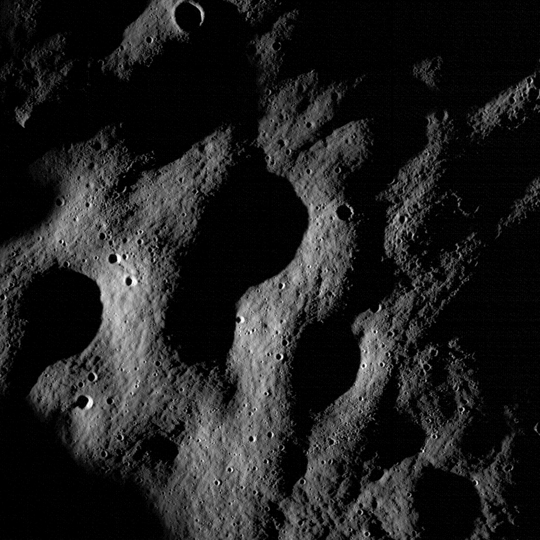
According to Robert Pearlman at collectSPACE, the LROC has some interesting sites lined up to image, including the imaging of Apollo landing sites.
However, the resolution of any images of Apollo sites will not be as good as those made later during the probe’s primary mapping orbit, a time when LRO will be at a lower altitude as it orbits the Moon.
The LROC Science Team has opened up a public request opportunity to suggest LROC Narrow Angle Camera targets using a public targeting tool. So, check it out and submit your requests!
The Apollo 15 and Apollo 16 landing spots are already on a list put together by NASA’s Constellation Program Office, as a “Regions of Interest” for the LROC. But all the Apollo sites are regions of interest for almost any space enthusiast!
Sources: NASA, collectSPACE,
By Gamma-Rays Alone: Fermi Raises the Curtain on 16 New Pulsars
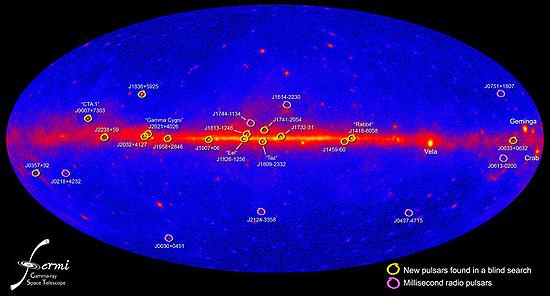
[/caption]
For the first time, NASA’s Fermi Gamma-ray Space Telescope has spotted a new group of pulsars using only their gamma-ray emissions, in the absence of radio signals beamed to Earth. The 16 new objects are reported in this week’s edition of Science Express, in a study based out of the University of California in Santa Cruz.
A pulsar is a rapidly spinning neutron star, the dense core left behind after a supernova explosion. Most of the 1,800 known pulsars were found through their periodic radio emissions.
“These are the first pulsars ever detected by gamma rays alone, and already we’ve found 16,” said co-author Robert Johnson, a UC Santa Cruz physicist. “The existence of a large population of radio-quiet pulsars was suspected prior to this, but until Fermi was launched, only one radio-quiet pulsar was known, and it was first detected in x-rays.”
Of the 16 gamma-ray pulsars, 13 are associated with unidentified gamma-ray sources detected previously by the EGRET instrument on the Compton Gamma-ray Observatory. EGRET detected nearly 300 gamma-ray point sources, but was unable to detect pulsations from those sources, most of which have remained unidentified, said Pablo Saz Parkinson, also a SCIPP postdoctoral researcher and corresponding author of the paper.
“It’s been a longstanding question what could be powering those unidentified sources, and the new Fermi results tell us that a lot of them are pulsars,” Saz Parkinson said. “These findings are also giving us important clues about the mechanism of pulsar emissions.”
A pulsar emits narrow beams of radio waves from the magnetic poles of the neutron star, and the beams sweep around like a lighthouse beacon because the magnetic poles are not aligned with the star’s spin axis. If the radio beam misses the Earth, the pulsar cannot be detected by radio telescopes. Fermi’s ability to detect so many radio-quiet gamma-ray pulsars indicates that the gamma-rays are emitted in a beam that is wider and more fan-like than the radio beam.
The team identified the gamma-ray pulsars in data from Fermi’s Large Area Telescope (LAT). Marcus Ziegler, a postdoctoral researcher at UC Santa Cruz and corresponding author of the paper, said detection of gamma-ray pulsations from a typical source requires weeks or months of data from the LAT.
“From the faintest pulsar we studied, the LAT sees only two gamma-ray photons a day,” Ziegler said.
The very intense magnetic and electric fields of a pulsar accelerate charged particles to nearly the speed of light, and these particles are ultimately responsible for the gamma-ray emissions.
Because the rotation of the star powers the emissions, isolated pulsars slow down as they age and lose energy. But a binary companion star can feed material to a pulsar and spin it up to a rotation rate of 100 to 1,000 times a second. These are called millisecond pulsars, and Fermi scientists detected gamma-ray pulsations from eight millisecond pulsars that were previously discovered at radio wavelengths. Those results are reported in a second study also published in the July 2 edition of Science Express.
“Fermi has truly unprecedented power for discovering and studying gamma-ray pulsars,” said Paul Ray of the Naval Research Laboratory in Washington. “Since the demise of the Compton Gamma Ray Observatory a decade ago, we’ve wondered about the nature of unidentified gamma-ray sources it detected in our galaxy. These studies from Fermi lift the veil on many of them.”
Lead image caption: This all-sky map shows the positions of 16 new pulsars (yellow) and eight millisecond pulsars (magenta) studied using Fermi’s LAT. Credit: NASA/DOE/Fermi LAT Collaboration
Sources: Science and UC Santa Cruz, via Eurekalert.


